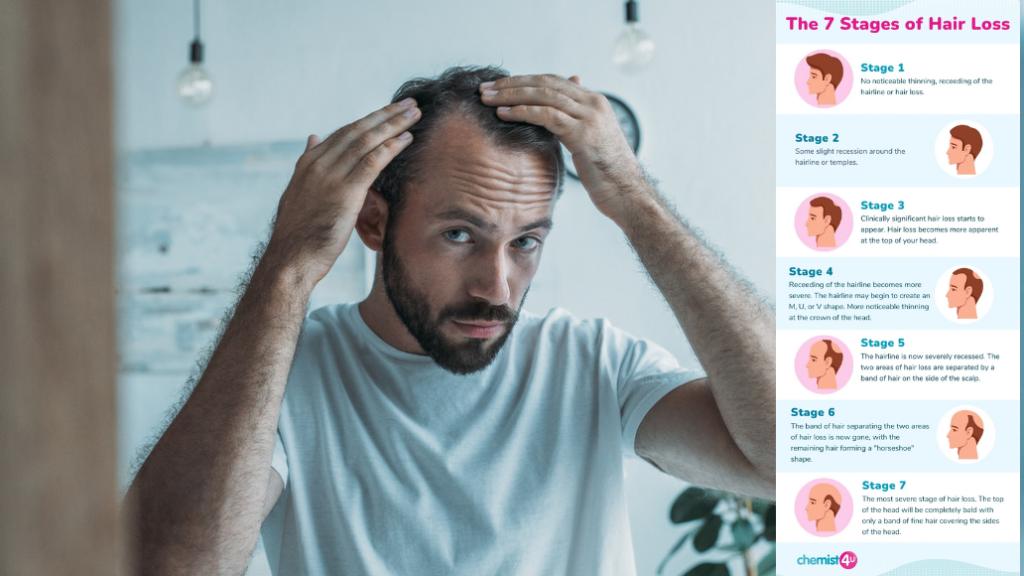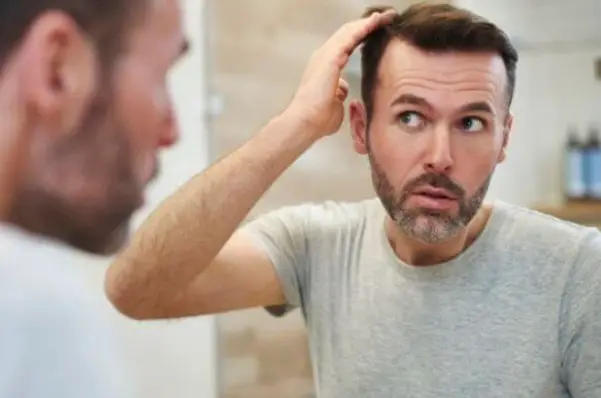Welcome to your comprehensive guide on Male Pattern Baldness Stages Time, a topic that affects many men but is often shrouded in mystery and misinformation. In this article, we aim to shed light on the stages and timeline of this common condition, providing you with the knowledge you need to understand and manage it effectively.
Male pattern baldness, also known as androgenic alopecia, is not just a cosmetic issue. It can have profound psychological effects, impacting self-esteem and mental health. But knowledge is power, and understanding the journey of male pattern baldness can help you navigate it with confidence and positivity.
In this article, we’ll delve into the science behind male pattern baldness, explore its stages, and discuss the timeline of its progression. We’ll also look at the early signs, causes, and treatment options available. Our goal is to provide you with a comprehensive resource that answers your questions and addresses your concerns.
Whether you’re experiencing hair loss yourself, know someone who is, or are simply curious about the topic, this article is for you. So, let’s embark on this journey together, shedding light on the path of male pattern baldness, from the first signs to the final stages.
Discover more about Male Pattern Baldness and its impact on men’s lives.
Stay tuned as we delve deeper into the world of hair loss, providing you with the information you need to take control of your hair health.
Related Article: Understanding the Genetics Behind Male Pattern Baldness stages
If you’re wondering about the early signs of male pattern baldness, check out our detailed guide on early stages of balding.
For those interested in natural ways to reverse male pattern baldness, we have an informative article on how to reverse male pattern baldness naturally.
If you’re considering medical treatments, we have resources on Minoxidil and Finasteride, two common treatments for male pattern baldness.
Remember, you’re not alone in this journey. We’re here to provide you with the information and resources you need to navigate the path of male pattern baldness.
Takeaways
Understanding male pattern baldness and its progression can help you take proactive steps towards managing this common condition. Here are the key takeaways from our comprehensive guide:
- Early Detection: Recognizing the early signs of male pattern baldness, such as a receding hairline or thinning hair, can help you take action sooner.
- Genetics and Hormones: The primary causes of male pattern baldness are genetics and hormones, particularly DHT. Lifestyle factors can also influence hair health and exacerbate hair loss.
- Treatment Options: There are several treatment options available that can slow the progression of hair loss and even help regrow some hair. These include lifestyle changes, medical treatments like minoxidil and finasteride, and surgical options like hair transplant surgery.
- Consultation: It’s important to consult with a healthcare professional or a hair loss expert if you’re experiencing signs of male pattern baldness. They can provide guidance, answer your questions, and help you choose the treatment that’s right for you.
Male Pattern Baldness Stages Time Table
Male pattern baldness stages time that usually takes 15-25 years to go bald, but it can be quicker
Here is a table that summarizes the typical timeline for male pattern baldness:
| Age | Time to Go Bald |
|---|---|
| Late Teens | 15-25 years |
| 30s | 15-25 years |
| Older Age | Varies |
Please note that these are general estimates and the progression of male pattern baldness can vary greatly from person to person. It’s always best to consult with a healthcare professional or a hair loss expert if you’re noticing signs of hair loss.
For more detailed information on male pattern baldness, check out our comprehensive articles on the receding hairline stages, causes, and treatment options.
Related Article: Crown balding stages
What is Male Pattern Baldness?
Male pattern baldness, or androgenic alopecia, is a common type of hair loss that affects many men worldwide. It’s a condition that typically develops gradually, often following a specific pattern. The process usually begins with a receding hairline, followed by thinning on the crown and temples, eventually leading to complete baldness in some cases.
The term “male pattern” comes from the characteristic M-shaped hairline that develops as the hairline recedes and hair thins at the crown. It’s a process that can start as early as the late teens to early twenties, but for many, it becomes more noticeable with age.
The primary cause of male pattern baldness is genetics. If your father or grandfather experienced hair loss, you’re more likely to experience it too. However, it’s not just about your family tree. Hormones also play a significant role, particularly an androgen (male hormone) called dihydrotestosterone (DHT). DHT causes hair follicles to shrink over time, leading to thinner hair and eventually, hair loss.
It’s important to note that male pattern baldness is not a disease or a sign of poor health. It’s a natural part of aging for many men. However, it can have a significant impact on self-esteem and mental well-being, making understanding and managing the condition crucial.
If you’re noticing signs of hair loss, it’s essential to remember that you’re not alone. Millions of men experience male pattern baldness, and there are resources available to help you navigate this journey.
For a more in-depth look at the causes and mechanisms of male pattern baldness, check out our detailed article here.
Related Article: Male Pattern Baldness dreadlocks
Stay tuned as we delve deeper into the stages of male pattern baldness in the next section.
Stages of Male Pattern Baldness
Understanding the stages of male pattern baldness can help you identify the condition early and take appropriate steps to manage it. The progression of hair loss is typically classified using a scale known as the Norwood Scale. This scale, developed by Dr. O’Tar Norwood in the 1970s, is still widely used today to categorize the stages of male pattern baldness.
Stage 1
In the first stage, hair loss is minimal and often unnoticeable. The hairline may start to recede slightly, but it’s typically not a cause for concern at this stage.
Stage 2
At stage 2, the hairline continues to recede at the temples, creating a more noticeable M-shape. However, the hair loss is still relatively mild.
Stage 3
This is the first stage that’s typically recognized as “baldness.” The hairline recedes more drastically at the temples, and there may be some loss at the crown as well.
Stage 4
In stage 4, hair loss becomes more severe. The hairline recedes further, and there’s noticeable thinning at the crown. However, there’s still a band of hair across the top of the scalp, separating the hair loss at the front and back.
Stage 5
Stage 5 is a more advanced version of stage 4. The areas of hair loss are larger, and the band of hair across the top of the scalp is narrower and thinner.
Stage 6
At stage 6, the band of hair across the top of the scalp is gone, and the hair loss areas at the front and back of the scalp join together.
Stage 7
This is the most severe stage of male pattern baldness. Only a band of hair around the sides of the scalp remains. This hair is typically not dense and may be fine in texture.
It’s important to note that the speed at which one progresses through these stages varies greatly from person to person. Some men may stay at one stage for years or even decades, while others may progress through the stages more quickly.
If you’re noticing signs of hair loss, it’s crucial to consult with a healthcare professional or a hair loss expert. They can help you identify the stage of your hair loss and discuss potential treatment options.
For a visual guide to the stages of male pattern baldness, check out our article here.
If you’re interested in understanding how to manage hair loss at different stages, we recommend reading Early Stages of Balding: What Can You Do?.
Related Article: How to Cope with Advanced Stages of Male Pattern Baldness
In the next section, we’ll discuss the timeline of male pattern baldness and factors that can influence its progression. Stay tuned!
Timeline of Male Pattern Baldness
The timeline of male pattern baldness is a highly individual process. It can start as early as the late teens and progress over many years, or it can begin later in life and progress more rapidly. Understanding this timeline can help you manage expectations and plan for potential treatment options.
Early Onset
For some men, signs of male pattern baldness can begin to appear in their late teens or early twenties. This is often characterized by a slight recession of the hairline and may progress slowly over many years. Early onset is often associated with a family history of male pattern baldness. If you’re noticing signs of hair loss at a young age, it’s important to consult with a healthcare professional or a hair loss expert. They can help you understand what’s happening and discuss potential treatment options.
Related Article: Receding hairline at 20
Mid-Life Onset
For many men, the signs of male pattern baldness become noticeable in their thirties or forties. This is often when the hairline recession becomes more noticeable, and thinning at the crown may begin. At this stage, the rate of hair loss can vary widely. Some men may experience slow, gradual hair loss over many years, while others may see a more rapid progression.
Late Onset
Some men may not notice any signs of hair loss until their fifties or later. In these cases, hair loss can progress at a variable rate, similar to mid-life onset. It’s important to note that even with late onset, treatment options are available and can be effective.
Factors Influencing the Timeline
Several factors can influence the timeline of male pattern baldness. Genetics play a significant role — if your father or grandfather experienced early or rapid hair loss, you’re more likely to as well. Hormonal factors, particularly levels of DHT, also influence the rate of hair loss. Lifestyle factors, such as diet, stress, and smoking, can also impact the timeline.
Understanding the timeline of male pattern baldness can help you manage the condition more effectively. If you’re noticing signs of hair loss, remember that you’re not alone and that help is available.
For more information on the timeline of male pattern baldness and factors that can influence it, check out our detailed article here.
If you’re wondering about the early signs of male pattern baldness, we recommend reading Early Stages of Balding: What Can You Do?.
Related Article: How to Slow Down the Progression of Male Pattern Baldness
In the next section, we’ll discuss the early signs of male pattern baldness and how to identify them. Stay tuned!
Early Signs of Male Pattern Baldness
Recognizing the early signs of male pattern baldness can be key to managing the condition effectively. The sooner you identify the signs, the sooner you can take steps to slow the progression and maintain your hair health. Here are some of the early signs to look out for:
Receding Hairline
One of the first signs of male pattern baldness is a receding hairline. This often starts at the temples, creating an M-shaped hairline. You might notice that your forehead appears higher or that your hair doesn’t style the same way it used to.
Thinning Hair
Another early sign is thinning hair, particularly at the crown of the head. You might notice that your hair looks less full or that you can see more of your scalp when your hair is wet or under bright light.
Hair Loss on the Pillow or in the Shower
Increased hair shedding can be an early sign of male pattern baldness. While it’s normal to lose some hair every day, if you’re noticing a significant increase in hair on your pillow, in the shower, or on your hairbrush, it could be a sign of male pattern baldness.
Changes in Hair Texture
Some men notice changes in their hair texture before they see noticeable hair loss. Your hair might feel finer or lack its usual volume.
If you’re noticing any of these signs, it’s important to consult with a healthcare professional or a hair loss expert. They can help you understand what’s happening and discuss potential treatment options. Remember, the sooner you act, the more options you’ll have for managing your hair loss.
For more information on the early signs of male pattern baldness and what you can do about them, check out our detailed article here.
If you’re wondering about the progression of male pattern baldness, we recommend reading Understanding the Stages of Male Pattern Baldness.
Related Article: How to Cope with Early Signs of Male Pattern Baldness
In the next section, we’ll delve into the causes of male pattern baldness and explore the role of genetics and hormones. Stay tuned!
Causes of Male Pattern Baldness
The causes of male pattern baldness are primarily genetic, but hormones and lifestyle factors can also play a role. Understanding these causes can help you manage the condition and take steps to maintain your hair health.
Genetic Factors
Genetics is the primary cause of male pattern baldness. If your father or grandfather experienced hair loss, you’re more likely to as well. Specific genes are thought to make some men more susceptible to the effects of dihydrotestosterone (DHT), a hormone that can cause hair follicles to shrink and eventually stop producing hair.
Hormonal Factors
Hormones, particularly DHT, play a significant role in male pattern baldness. DHT is a byproduct of testosterone, the primary male sex hormone. In men susceptible to male pattern baldness, DHT can bind to receptors in the hair follicles, causing them to shrink and eventually stop producing hair.
Lifestyle Factors
While genetics and hormones are the primary causes of male pattern baldness, lifestyle factors can also influence hair health. Stress, poor nutrition, smoking, and certain medical conditions can exacerbate hair loss. Maintaining a healthy lifestyle can help support your hair health and may slow the progression of hair loss.
If you’re experiencing signs of male pattern baldness, it’s important to consult with a healthcare professional or a hair loss expert. They can help you understand the causes of your hair loss and discuss potential treatment options.
For more information on the causes of male pattern baldness and how to manage them, check out our detailed article here.
If you’re interested in the genetic factors behind male pattern baldness, we recommend reading Understanding the Genetics Behind Male Pattern Baldness.
Related Article: How Lifestyle Factors Influence Male Pattern Baldness
In the next section, we’ll explore treatment options for male pattern baldness, from lifestyle changes to medical treatments. Stay tuned!
Treatment Options for Male Pattern Baldness
While male pattern baldness is a common condition, it doesn’t mean you have to simply accept it. There are several treatment options available that can slow the progression of hair loss, help regrow lost hair, or manage the condition in a way that suits you best.
Lifestyle Changes
Making certain lifestyle changes can help support your hair health and potentially slow the progression of hair loss. This can include maintaining a balanced diet, reducing stress, avoiding smoking, and taking care of your hair by avoiding harsh treatments and products.
Medical Treatments
There are several medical treatments available that can help slow hair loss and even promote hair regrowth. These include:
- Minoxidil: An over-the-counter topical treatment that can help slow hair loss and promote hair regrowth. It’s typically applied to the scalp twice a day.
- Finasteride: A prescription medication that blocks the production of DHT, the hormone responsible for hair loss in men. It’s taken orally once a day.
Hair Transplant Surgery
For some men, hair transplant surgery may be an option. This involves transplanting hair follicles from one part of the scalp to another. While it can be effective, it’s also more invasive and expensive than other treatment options.
Natural Remedies
Some men prefer to explore natural remedies for hair loss. This can include herbal supplements, scalp massages, and certain hair care practices. While the effectiveness of these remedies can vary, some men find them helpful.
Remember, it’s important to consult with a healthcare professional or a hair loss expert before starting any new treatment. They can help you understand your options and choose the treatment that’s right for you.
For more information on treatment options for male pattern baldness, check out our detailed article here.
If you’re interested in natural ways to reverse male pattern baldness, we recommend reading How to Reverse Male Pattern Baldness Naturally.
Related Article: Exploring Medical Treatments for Male Pattern Baldness
In the next section, we’ll answer some frequently asked questions about male pattern baldness. Stay tuned!
Frequently Asked Questions
Here are some frequently asked questions about male pattern baldness:
When does male pattern baldness usually start?
Male pattern baldness can start at any age after puberty, but it’s most commonly noticed in men in their thirties or forties. However, it can start as early as the late teens in some men, particularly those with a strong family history of early baldness.
How long does it take to go bald once you start thinning?
The rate at which hair loss progresses can vary greatly from person to person. Some men may notice gradual thinning over many years, while others may experience more rapid hair loss. It’s important to consult with a healthcare professional or a hair loss expert if you’re noticing signs of hair loss.
Can male pattern baldness be reversed?
While male pattern baldness can’t be completely reversed, there are treatments available that can slow the progression of hair loss and even help regrow some hair. These include over-the-counter treatments like minoxidil, prescription medications like finasteride, and surgical options like hair transplant surgery.
What causes male pattern baldness?
The primary cause of male pattern baldness is genetics. If your father or grandfather experienced hair loss, you’re more likely to as well. Hormones, particularly DHT, also play a significant role. Lifestyle factors, such as diet, stress, and smoking, can also influence hair health and exacerbate hair loss.
For more information on male pattern baldness, check out our detailed article here.
If you’re wondering about the early signs of male pattern baldness, we recommend reading Early Stages of Balding: What Can You Do?.
Related Article: Understanding the Stages of Male Pattern Baldness
In the next section, we’ll wrap up our discussion on male pattern baldness. Stay tuned!
Conclusion
Male pattern baldness is a common condition that many men experience at some point in their lives. While it can be distressing, it’s important to remember that you’re not alone and that there are many resources and treatments available to help manage the condition.
Understanding the stages and timeline of male pattern baldness can help you identify early signs and take action sooner. Remember, the sooner you act, the more options you’ll have for managing your hair loss.
Whether you’re noticing the first signs of a receding hairline or you’re further along in the process, it’s never too late to take steps to support your hair health. From lifestyle changes to medical treatments, there are many ways to slow the progression of hair loss and maintain your confidence.
Remember, it’s important to consult with a healthcare professional or a hair loss expert if you’re experiencing signs of male pattern baldness. They can provide guidance, answer your questions, and help you choose the treatment that’s right for you.
Thank you for joining us in this comprehensive exploration of male pattern baldness. We hope you found this information helpful and empowering. Remember, you’re not alone in this journey, and there are many resources available to help you navigate it. Stay tuned for more informative articles on hair health and baldness!
- AI Powered Bald Filter Online 2024: See Yourself with No Hair! - January 19, 2024
- Harklinikken Bad Reviews 2024: Analyzing Negative Feedbacks - January 18, 2024
- How to Get the Alex Eubank Hair | Step-By-Step Tutorial 2024 - January 18, 2024







